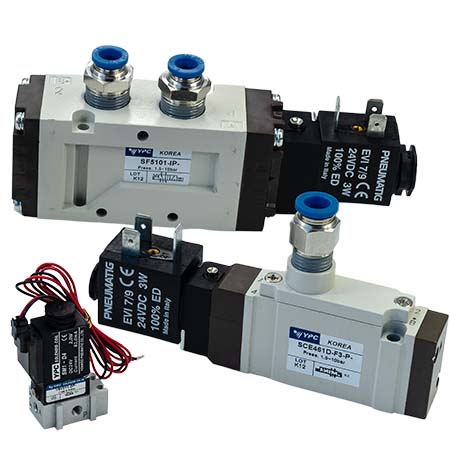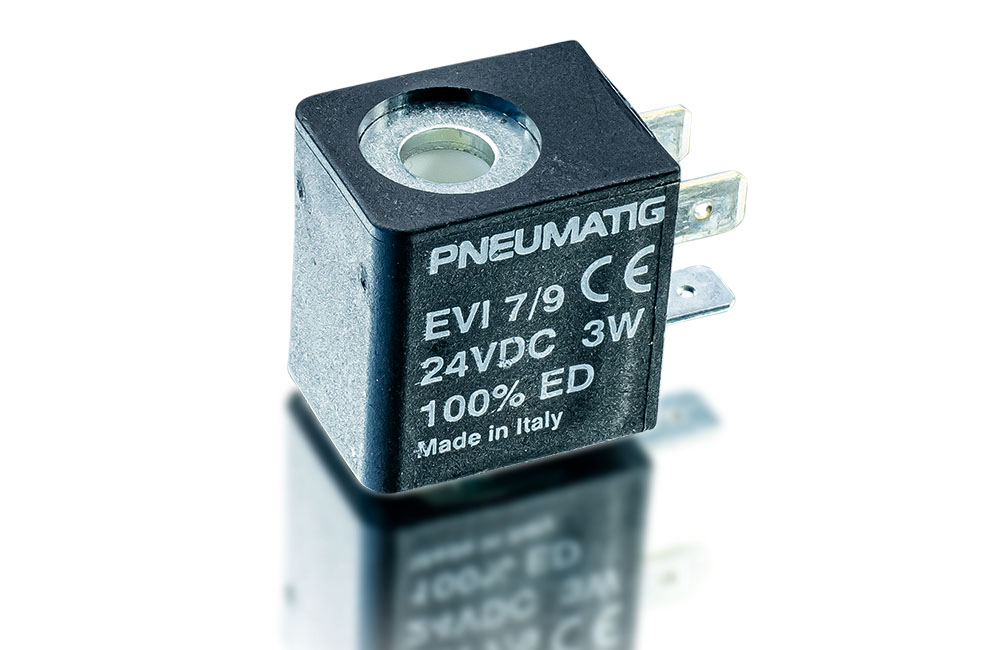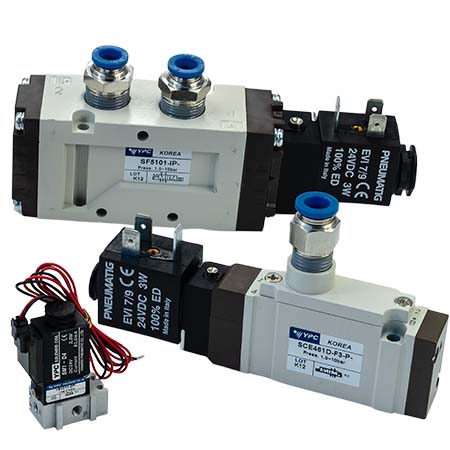How does a pneumatic solenoid valve work? In this article we provide concrete answers. A pneumatic solenoid valve is a device used to control air flow in pneumatic systems. It is equipped with an electromagnet that opens or closes the valve when voltage is applied. The working principle of the pneumatic solenoid valve is based on the effect of the electromagnetic field generated by the electromagnet when voltage is applied.
Structure of a pneumatic solenoid valve
The pneumatic solenoid valve consists of several basic elements. The core of the electromagnet consists of a ferromagnetic material on which electrical coils are wound. The core is connected to a movable valve element that acts as a piston or flap. Depending on the type of solenoid valve, the movable element can be mounted on a spring or directly on the magnetic core.

The main element of the pneumatic solenoid valve is an electromagnet, which creates an electromagnetic field when voltage is applied. This field pulls the movable element of the valve towards the electromagnetic core, opening the valve. When the voltage is interrupted, the electromagnet loses its magnetic properties and the movable element of the valve returns to its original position due to the action of the spring or the action of the electromagnet core itself.
How does a pneumatic solenoid valve work? Here are the basic elements
The pneumatic solenoid valve consists of several basic elements, such as:
- Solenoid housing – the external element of the solenoid valve, designed to protect the internal elements of the device from mechanical damage and climatic influences. The box can be made from different materials, such as metal, plastic or rubber.
- Solenoid valve coil – a solenoid valve element containing a movable core mounted in a sleeve. The coil is supplied with electrical voltage, causing it to heat up. Depending on the type of solenoid valve, the coil can be made from different materials, such as copper, aluminum or steel.
- Solenoid sleeve – an element in the solenoid valve that serves as a guide for the coil core. The sleeve is made of high quality materials such as brass, stainless steel or plastic, which guarantees high durability and reliability of the solenoid valve.
- Magnetic core – a solenoid valve element that is placed in the sleeve and moves with the solenoid valve coil.
- Magnetic plate – solenoid valve element that acts as a piston rod and is mounted on the sleeve. The plate is made of plastic or metals such as aluminum or brass and is used to force air from one side of the solenoid valve to the other.
- Solenoid flapper – an element in the solenoid valve that acts as a valve to regulate air flow. The flap is mounted on the sleeve and moves with the spool core. Depending on the purpose of the solenoid valve, it can be made from different materials such as plastic, metal or rubber.
- Magnetic springs – elements of the solenoid valve that serve to press the flap on the solenoid valve plate, thus ensuring the tightness of the pneumatic system. Depending on the purpose of the solenoid valve, magnetic springs can be made from different materials, such as steel, resilient plastic or rubber. For solenoid valves with large air flow cross-sections or high pressures, higher strength springs are used to ensure that the solenoid valve works properly.
- Electrical Connections – Components of a solenoid valve used to connect the solenoid valve coil to power. Connections can be in the form of plugs or sockets and their type and connection method depend on the type of solenoid valve.
- Pneumatic Connections – Solenoid valve elements that are used to connect the solenoid valve to the pneumatic system. Connections can be in the form of threads or terminals, and their type and connection method depend on the type of solenoid valve.
- Solenoid valve restrictors – are mounted at the inlet and outlet of the solenoid valve to regulate air flow. Depending on the purpose of the solenoid valve, Venturi tubes can be designed as flaps or movable pistons. Its use allows precise control of the air flow in the pneumatic system, which is especially important in complex systems that require precise control of the operation of individual elements.
The use of a pneumatic solenoid valve in pneumatic systems
Pneumatic solenoid valve is widely used in various pneumatic systems, such as material handling systems, production machines, refrigeration systems and security systems. It can also be used in hydraulic systems where it acts as a valve to control the flow of oil.

How does a pneumatic solenoid valve work? Many people who are concerned with the automation of production processes or other applications certainly ask themselves this question. Pneumatic solenoid valve is a reliable and easy-to-use device that is widely used in various industrial sectors. Thanks to its flexibility and easy configuration, the pneumatic solenoid valve is a valuable tool in the automation of production processes and other applications.
Control of pneumatic solenoid valves: types of signals, air flow control methods
If you're wondering how a pneumatic solenoid valve works, we have the answer for you.
Pneumatic solenoid valve control requires supplying a suitable electrical signal to the electromagnet responsible for opening or closing the valve. The pneumatic solenoid valve can be controlled with different types of signals depending on the system requirements and the specific solenoid valve model.
The signal that controls the pneumatic solenoid valve can be a direct or alternating voltage, a current of different frequencies or a digital signal. Each of these types of signals has its own properties and applications. Therefore, carefully read your solenoid valve manual to find out which signal type is suitable for your specific model.
In addition to the type of signal, an important element of pneumatic solenoid valve control is how to control the air flow. Depending on the system needs and specific requirements, the pneumatic solenoid valve can be controlled in continuous or pulsed operation.
In continuous mode, an electrical signal is continually applied to the solenoid, causing the valve to continuously open or close. This mode is used when a constant flow of air or oil must be maintained.
In pulsed mode, an electrical signal is provided in short pulses that cause the valve to open and close at specific time intervals. This mode is used when it is necessary to control the air flow in intervals or pulses.
What are additional elements of the pneumatic solenoid valve used for? Springs, flaps and throttles
The pneumatic solenoid valve can be equipped with additional elements that perform different functions and allow the device to better adapt to the specific needs of the system.
Springs are used to automatically close or open the valve when voltage is interrupted or applied. Springs are installed in pneumatic solenoid valves where it is necessary to maintain constant pressure in the system or automatically close the valve after turning off the voltage.
Flaps and Venturi tubes are used to regulate airflow. The movable valve element can be used to open or close the pneumatic solenoid valve flaps, allowing air flow adjustment. Restrictors, on the other hand, are used to limit airflow. This may be necessary when system capacity is limited or pressure in the system needs to be reduced.
Both elements are particularly useful in pneumatic systems where precise control of air flow is required. Thanks to them, it is possible to precisely adjust the system's operating parameters to specific needs and requirements.
Pneumatic solenoid valve repair and maintenance: troubleshooting and troubleshooting methods
Pneumatic solenoid valve, like other pneumatic devices, requires regular maintenance and repairs to ensure proper operation and reliability. In the event of failure or damage to the solenoid valve, it is necessary to accurately diagnose the fault and take appropriate corrective measures.
When diagnosing malfunctions in pneumatic solenoid valves, the goal is to determine the cause of the error and correct it. To diagnose the error, carefully analyze the error symptoms and check the operation of the individual solenoid valve components. This may include checking the condition of the solenoid valve, movable valve element, springs and other components. If you are unable to diagnose it yourself, you may need to seek help from a professional or contact the solenoid valve manufacturer or supplier for assistance in diagnosing and correcting the problem.
If a fault with the pneumatic solenoid valve is detected, appropriate corrective measures must be taken. Depending on the type of failure and its severity, it can be resolved by replacing the damaged elements or the entire solenoid valve. When replacing elements, carefully read the solenoid valve manual and follow its recommendations. If the entire solenoid valve is to be replaced, it may be necessary to seek the services of a specialist or contact the manufacturer or supplier for assistance in installing the new device.
Remember that regular maintenance of the pneumatic solenoid valve will help prevent breakdowns and increase the reliability of the device. Therefore, you should regularly check the condition of the solenoid valve and carry out regular inspections and maintenance in accordance with the manufacturer's recommendations.
What is the brand of pneumatic solenoid valve?
Keep in mind that selecting the appropriate pneumatic solenoid valve has a significant impact on the reliability and efficiency of the pneumatic system. Therefore, it is worth paying attention to the quality and reputation of the solenoid valve manufacturer and distributor.
YPC is a renowned manufacturer of pneumatic solenoid valves and offers a wide range of devices with different parameters and purposes. YPC solenoid valves feature high quality and reliability, making them an ideal choice for production lines where system reliability is critical.
Pneumatig is an authorized distributor of YPC pneumatic solenoid valves. It offers a wide range of equipment as well as professional advice and support in selecting the appropriate solenoid valve for specific plant needs and requirements. Pneumatig also offers a wide range of services, including repair and maintenance of solenoid valves, ensuring system reliability over a long period of time.
We invite you to discover the range of YPC pneumatic solenoid valves available on the Pneumatig website. (If you have any questions or concerns, please contact our experts who will be happy to help you choose the right solenoid valve for your specific pneumatic system needs and requirements.
Remember that a correctly selected pneumatic solenoid valve and regular maintenance and repairs guarantee the efficiency and reliability of the pneumatic system, which is reflected in its efficiency and savings in time and costs.

























































